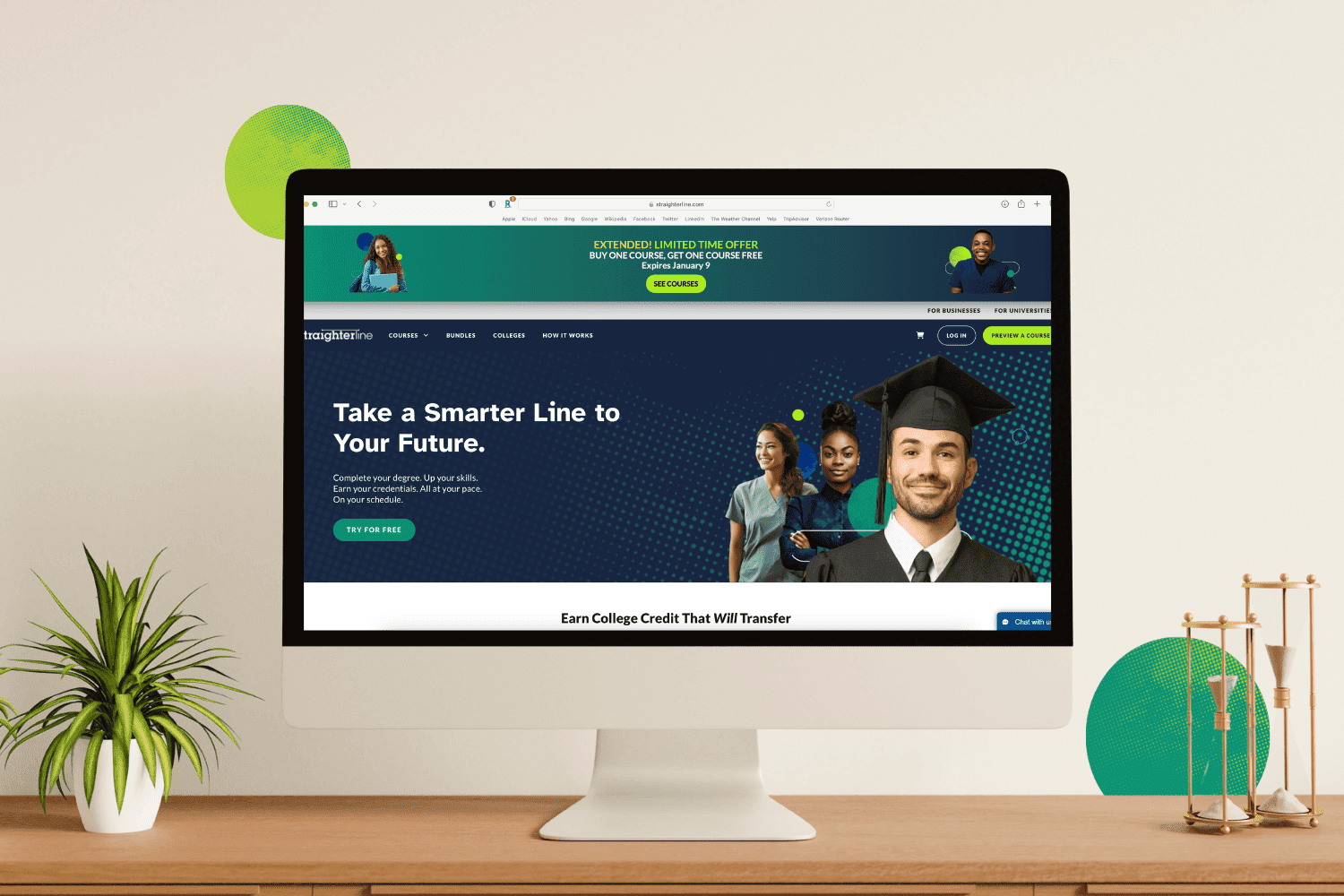You're here because you're wondering — what is credit-by-exam or CBE? If you’ve ever wished you could skip a class because you already know the material, that’s exactly what Credit-by-Exam (CBE) allows you to do. Instead of spending weeks or months in a course, you can prove your knowledge by taking one comprehensive exam. Pass it, and you can earn college credit at participating institutions — no classroom time required.
Credit-by-exam programs can be a smart way to save both time and tuition, especially if you already have work experience or prior learning in the subject. However, CBE isn’t the right fit for everyone. These exams typically require independent study and only cover specific subjects. Plus, not every college accepts all forms of exam credit, so it’s important to check your school’s transfer policies before diving in.
If you like the flexibility of earning credit outside a traditional classroom but want more support than a single test, StraighterLine’s online courses let you move at your own pace, complete quizzes and assignments along the way, and still earn affordable, transferable college credit — no exam-day stress required. Here's more about how credit-by-exam works, popular CBE providers, and how you can use it to get credit towards your degree.
TL;DR: What is Credit-By-Exam (CBE)?
- What is credit-by-exam or CBE? It's a process of getting college credit by “testing out” of specific college-level courses you already know.
- Some of the top Credit-by-Exam providers are CLEP, DSST, AP, and University Challenge Exams
- Each college or university has its own policy on whether they accept credit-by-exam. Some institutions might require CBE from one provider, require a specific score threshold, or limit the number of credits while other schools won't accept CBE at all.
Some of the drawbacks of CBE are that there's a waiting period for retakes, the tests are high stakes, and there is limited support. If you want a more complete learning experience, you might consider getting college credit through a provider like StraighterLine instead.
How Does Credit-by-Exam Work?
At its core, CBE is designed for students who can demonstrate subject mastery — whether through self-study, work experience, prior learning, or intense preparation. Here’s the basic process:
Select the Exam: Choose which subject area aligns with a course you’d otherwise need to take at college.
Register & Pay: Sign up with the testing provider and pay their exam fee (often between $90–$100).
Study & Prepare: Brush up on the material. You might use textbooks, online resources, or your own knowledge from personal or professional experiences.
Take the Exam: Complete the test either online (if offered) or at a designated testing center.
Score & Credit Transfer: If you pass with the required score, your chosen college may grant you credit — cutting out the need to take that full semester-long course.
This process can be a huge advantage if you’re confident in your knowledge. However, acceptance of these credits isn’t guaranteed — each institution sets its own rules about which exams they recognize and what minimum scores they accept.
Popular Credit-by-Exam Providers
There’s no single CBE provider that works for everyone. Different organizations offer exams in a variety of subjects, formats, and price points. Plus, the policies at each college or university will vary. Here’s a quick comparison:
| CBE Provider | Number of Tests | Cost per Exam | Retest Waiting Period | Accepted Scores/Policies |
| CLEP (College-Level Examination) | 34 exams in 5 subject areas | $90 | 3 months | Varies by institution. Many schools require a minimum CLEP score of 50. |
| DSST (DANTES Subject Standardized Tests) | 37 exams in 6 subject areas | $100 | 30 days | School-specific policies; minimum scores vary. |
| AP (Advanced Placement) | Varies by high school courses | $97 per exam | 1 year (exam repeated next year) | Most colleges require a 3+ (on a 5-point scale). High school typically covers the course cost. |
| University Challenge Exams | Depends on the institution | Varies | Varies (institution-specific) | May let you skip a class, but not always grant formal credit. |
Pro Tip: Always confirm with your academic advisor or registrar’s office that your desired exam will be accepted before you spend time and money prepping.
CLEP: A Snapshot
What It Is: The College-Level Examination Program, run by the College Board.
What It Offers: 34 exams in subjects like Composition, Math, Science, and more.
Cost & Retest Policy: $90 per exam; wait 3 months to retest if you don’t pass.
Acceptance: Policies vary by school; verify minimum scores your target institution requires.
Testing Style: Multiple-choice, sometimes essays
Who It’s Best For: Students with a solid background in high school or independent study, or those who’ve gained relevant knowledge through work experience
The College-Level Examination Program® (CLEP) is offered by the College Board, a non-profit organization. They offer 34 tests in five subjects for $90 per exam. Colleges and universities set their own policies concerning whether they accept CLEP exam results and, if so, the minimum score they will accept. Exams are offered at official CLEP testing centers around the country or online via remote proctoring. Failure to pass a CLEP exam requires a three-month waiting period before you can retest.
DSST: A Closer Look
What It Is: Defense Subject Standardized Tests, historically used by military personnel but open to civilians.
What It Offers: 37 exams in six broad subject areas, including Social Sciences, Math, and Business.
Cost & Retest Policy: $100 per exam; wait 30 days to retest if you don’t pass.
Acceptance: Individual colleges set their own acceptance policies and required scores.
Origin: Developed for military personnel but open to civilians
Key Benefit: You can often take these tests online, but check for test center availability in your area
The Defense Subject Standardized Test (DSST) is another exam company that offers both in-person testing at designated facilities as well as online proctored testing. There are 37 exams in six subjects for $100 per exam. Failure to pass a test with DSST requires a 30-day waiting period to retest. As with CLEP, your chosen school will have its own policies regarding accepting DSST credits and scores.
AP: Advanced Placement in High School
What It Is: College-level coursework typically taken in high school.
What It Offers: 38 subjects, ranging from Art History to Calculus, with an end-of-year exam.
When It’s Offered: Usually to high school juniors and seniors
Acceptance: Most colleges require at least a 3 on a 5-point scale to award credit.
Cost & Format: $97 per exam; includes a year-long (or semester-long) advanced course in high school
Retest Policy: $97 per exam; retest only possible the following year.
Advanced Placement® (AP) classes are generally offered to students in high school. These are college-level courses that can be taken in place of regular high school-level classes during the school day. Students may start taking AP classes as early as 9th grade. There’s no extra cost to take an AP class at school. At the end of your AP class, you’ll be administered an exam, which costs $97 per course. Most colleges and universities will not accept a score lower than a 3 on the exam (which equates to a C grade) when transferring the course for credit. Exams may be repeated the following year. As always, check with your chosen college or university’s AP exam policies to find out which courses to take and what minimum passing score you need.
University Challenge Exams
What They Are: Exams offered directly by a specific college or university for certain courses.
Pros: May help you skip a class if you show proficiency.
Cons: Not always a direct credit award. Some schools only let you bypass the class but still require you to earn those credits elsewhere.
Main Caveat: Some schools might only allow you to skip the course rather than actually earning credit. Make sure you’ll still get the credit hours you need to graduate.
How Is Credit Awarded with CBE Testing?
Here’s where things can get a bit tricky. Each college or university has its own policy on if — and how — they accept credit-by-exam. Some institutions might:
Only Recognize One Provider: They might take CLEP but not DSST, or AP but not CLEP.
Require a Specific Score Threshold: A college might need a CLEP score of at least 50, while another school might want a 55.
Limit the Number of Credits: You may only be allowed to apply a certain number of CBE credits toward your degree.
Reject CBE Entirely: A handful of institutions don’t accept any form of test-based credits at all.
Bottom line? Always talk to an advisor at your target institution to verify their policies. Doing your homework first can save you the frustration of paying for an exam that won’t actually help you graduate any sooner.
When Credit-by-Exam Might Fall Short
While CBE can be a big time-saver, it has certain drawbacks:
Waiting Periods for Retakes: If you fail, you often must wait 30 to 90 days (or even a full year for some AP courses) before you can try again.
High-Stakes Test: You have just one exam to prove mastery of the entire subject. If you don’t test well under pressure, CBE can be risky.
Limited Support & Resources: Many CBE programs leave studying entirely up to you. If you need tutoring or academic guidance, you’ll have to find and pay for it separately.
Why StraighterLine May Be a Better Option
StraighterLine isn’t a test-out model but an online course provider that offers a full learning experience — quizzes, assignments, instructor resources, and final exams. Here’s why it might fit your goals better than CBE:
No Strict Retest Waiting Period
If you don’t pass a course on your first try, you can re-enroll without waiting months or losing valuable time.Guaranteed Transfer Agreements
StraighterLine partners with 180+ colleges and universities, guaranteeing your credit transfer. Plus, 3,000+ institutions have accepted StraighterLine courses through ACE CREDIT®.Affordable, Transparent Pricing
$99 monthly membership + $79 per course
Free eTextbooks, tutoring, and 24/7 student support included.
Flexible, Self-Paced Learning
You’re not tied to a strict exam date. Study on your schedule and move faster — or slower — depending on your comfort level.Full Course Experience
Instead of a single high-stakes test, you’ll engage with the subject matter through graded assignments, interactive lessons, and final exams that ensure you truly grasp the material. We offer over 75 courses in various subject areas.
Comparing CBE & StraighterLine
| Credit-by-Exam (CBE) | StraighterLine | |
| Format | One high-stakes test to demonstrate subject mastery | Full course experience (lessons, quizzes, assignments, final exam) |
| Retest Policy | Mandatory waiting periods (30 days, 3 months, or 1 year) for most providers | No mandatory waiting period; just re-enroll if needed |
| Cost Structure | Pay per exam (usually $90–$100), separate study materials often extra | $99 monthly membership (includes eTextbooks, tutoring, & more) + $79 per course |
| Transfer Guarantees | Varies widely; some schools accept certain exams, others do not | 180+ partner schools guarantee credit; credits have transferred to 3,000+ colleges and universities via ACE CREDIT |
| Learning Resources | Self-study (you’re on your own) | Access to complimentary eTextbooks, 24/7 tutoring, and student support |
| Suitability | Great if you already know the material thoroughly and test well under pressure | Ideal for structured learners seeking flexibility, cost savings, and academic support |
Ready to Save Time and Money?
If you’re uncertain about CBE, or if your target school’s policies seem complicated, StraighterLine can give you a clear, supported path to earning college credit. Get a sneak peek at what’s inside with our free course preview!
Don’t let traditional tuition prices or confusing credit-by-exam policies hold you back — speak with one of our Enrollment Specialists today, or check out our course catalog to see how you can jump-start your degree on your schedule, with total confidence in your credit transfer.
FAQs
Can I mix and match CBE with online courses like StraighterLine?
Absolutely. Some students take CBE for subjects they know very well and enroll in StraighterLine or other online courses for areas where they need more structured support.
Do all schools accept CLEP or DSST for credit?
No. Each school sets its own policy, and some may only grant partial credit or none at all. Always confirm before scheduling an exam.
What happens if I fail a CBE exam?
Typically, you must wait a set period (30 days to 1 year) before retaking the same exam. Additionally, you’ll pay the exam fee again.
Is StraighterLine accredited?
StraighterLine is not a degree-granting institution and thus not accredited in the same manner as a college. However, their courses carry ACE CREDIT recommendations, and they have guaranteed transfer agreements with partner colleges.
How can I decide if CBE is right for me?
Consider your test-taking skills, your confidence in the subject matter, and the requirements of your chosen college. If you’re confident you can pass a single exam and your school accepts that test, CBE could work. If you’d prefer a more guided, flexible approach with guaranteed transfer, StraighterLine might be the better choice.
Is credit-by-exam the same as an online course?
No, credit-by-exam isn’t the same as an online course. With credit-by-exam, you earn credit by passing one comprehensive test, while online courses involve lessons, assignments, and quizzes completed over time before earning credit.











